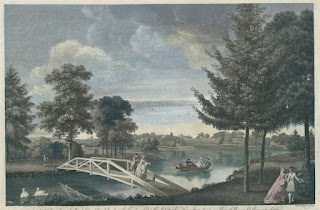I'll be posting a full review of Claire's marvellous new book, The Golden Age of the Garden, later this month but, with half the book still to go, I'm delighted to report that it's another wonderful, essential read!
---oOo---
The eighteenth and nineteenth centuries saw a golden era of garden design in England – the Renaissance formal gardens with their elaborate geometric hedges, clipped lawns and ordered planting made way for the more naturalistic style of the landscape garden. Designers such as William Kent, Lancelot ‘Capability’ Brown and Humphry Repton, inspired by nature, transformed the English landscape.
During the Georgian period the English garden became a subject for intellectual debate, with writers and thinkers discussing the national landscape. Thomas Whately’s Observations on Modern Gardening (1770) was one of the most influential tomes on English gardening, helping to frame the ideas of the landscape garden:
‘Gardening, is the perfection to which it has been lately brought in England, is entitled to a place of considerable rank among the liberal arts. It is as superior to landskip [landscape] painting, as a reality to a representation: it is an exertion of fancy, a subject for taste; and being released now from the restraints of regularity, and enlarged beyond purposes of domestic convenience, the most beautiful, the most simple, the most noble scenes of nature are all within its province: for it is no longer confined to spots from which it borrows its name, but regulates also the disposition and embellishments of a park, a farm, or a riding; and the business of a gardener is to select and to apply whatever is great, elegant, or characteristic in any of them; to discover and to shew all the advantages of the place upon which he is employed; to supply its defects, to correct its faults, and to improve its beauties. For all these operations, the objects of nature are still his only materials.’
 |
| Uvedale Price |
Essayist Uvedale Price (1747–1829) and artist, cleric and writer William Gilpin (1724–1804) were both preoccupied with the idea of the picturesque, a recently coined term which at that time applied to a view which might invite the landscape painter to capture it. Uvedale Price considered many aspects of nature in his An Essay on the Picturesque (1796):
‘Among trees, it is not the smooth young beech, or the fresh and tender ash, but the rugged old oak, or knotty wych elm, that are picturesque; nor is it necessary they should be of great bulk; it is sufficient if they are rough, mossy, with a character of age, and with sudden variations in their forms. The limbs of huge trees, shattered by lightning or tempestuous winds, are in the highest degree picturesque; but whatever is caused by those dreaded powers of destruction, must always have a tincture of the sublime.’
With this background of intellectual discussion on the nature of beauty many contemporary gardeners took these ideas and began to apply them to gardening, ushering in a style more sympathetic to nature, and yet carefully planned to lend variety and interest. One of the innovations which characterises Georgian era gardens was the use of the ha, ha!:
‘The capital stroke, the leading step to all that has followed, was (I believe first thought was Bridgman’s) the destruction of walls for boundaries, and the invention of fossès – an attempt then deemed so astonishing, that the common people called them Ha! Ha’s! to express their surprize at finding a sudden and unperceived check to their walk . . . I call a sunk fence the leading step, for these reasons. No sooner was this simple enchantment made, than levelling, mowing and rolling, followed. The contiguous ground of the park without the sunk fence was to be harmonized with the lawn within; and the garden in its turn was to be set free from its prim regularity, that it might assort with the wilder country without.’
– The History of the Modern Taste in Gardening by Horace Walpole (1780)
By opening up the views to the fields beyond it allowed the garden to become part of a wider landscape. This idea informed the design of the garden itself with serpentine paths allowing the visitor to wander through the garden, greeted with a new vista at every turn.
 |
| Painshill |
The Georgian landscape garden although inspired by nature it was very much planned by man. A fashion for building ruined follies, secluded hermitages and decaying bridges persisted, providing moments of drama in the garden or places of contemplation. Bodies of water were also popular, from a modest fountain to the dramatic cascades and jet d’eaus seen at gardens such as Chatsworth.
Trees were planted in groves, belts and clumps (something Uvedale Price took great dislike for, remarking somewhat churlishly ‘But the great distinguishing feature of modern improvement, is the clump; whose name if the first letter was taken away, would most accurately describe its form and effect.’). The effect of planting trees in this way was to delineate the garden and draw the eye, great thought went into the planting of these groves and clumps, ensuring variety of form and colour.
Landscape gardening reflects the Georgian’s changing relationship with the national landscape – no longer did people want unnatural and artful formal gardens, instead they wanted large open parks, ridings and ornamented farms which allowed visitors to meander at their leisure. Landscape gardens provided an idealised version of English pastoral scenes, a style which has proved enduring as attested by the famed gardens at Chatsworth, Blenheim, Painshill and Stowe which still reflect their Georgian designs.
The Golden Age of the Garden by Claire Cock-Starkey published by Elliott & Thompson is released on 4 May 2017.
Picture credits: Portrait (c. 1799), oil on canvas, of Sir Uvedale Price, 1st Baronet (1747–1829), by Sir Thomas Lawrence, (1769–1830)
Engraving of Painshill by William Woolett, 1760s

No comments:
Post a Comment